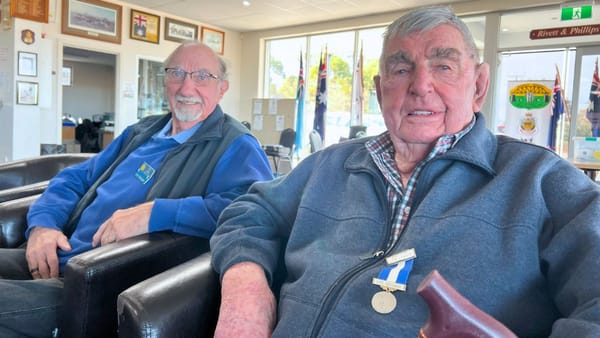Join in ... with the Kanmantoo-Callington Landcare Group
Rose Ashton and Ed and Tess Thomas invite you to get involved with conservation in the Bremer Valley.

This story has been made free to read under Murray Bridge News’ editorial policy on community features. Please consider supporting our work by subscribing.

Behind the Callington hall is a patch of scrub with a path winding through it.
Anyone who needs to escape life’s pressures can wander among native plants and sculpted boulders, up to the 160-year-old smelter whose chimney still stands on the town’s western skyline, then back around the ovals across the road.
Creating the Bremer Boot Trail, as it is called, has been one of many projects for the Kanmantoo-Callington Landcare Group in recent years.
Rose Ashton offers an extensive list: plantings, weeding, field trips, lobbying mining companies and councils, improving Steele Road Reserve – and that is just since the pandemic started.
Over-arching all those activities is the Bremer Valley’s growing population, and growth in the number of locals interested in transforming their bare paddocks back into the woodlands they once were.
Among the couples involved in that effort, and the Landcare group, are Ed and Tess Thomas.
When did you first get involved with the Landcare group?
Tess: Probably about 18 years ago. We've lived here about 20 years.
Ed: We bought a 96-acre property with three trees on it. We wanted plants to bring habitat and wildlife in. We had three species of bird; now we’ve got 600 trees and 25 species of bird … It’s not just revegetation. Re-wilding, that’s what it is. Now we’re getting all the lizards and whatever moving back in.
What do you spend your time doing?
Ed: We do roadside plantings, and we occasionally support people on new properties or who’ve had a fire, that kind of thing.
Tess: We have about three or four meetings a year, then we have working bees – we put lots of man-hours in … We always have a stall at the Callington Show ... (But mostly) we get our hands dirty. Wheelbarrows and picks.
Ed: For that reason, we’re looking for younger people. We don’t want (Landcare) to be seen as a retirement thing, because it’s important. We’re looking for community groups, even corporate groups, to give us a hand.

What do you get out of your involvement?
Ed: There’s a good interchange of knowledge and practical understanding about how the environment works, getting the right trees for the right place.
Tess: It’s the thrill of seeing things grow, bushing up and having birds and that coming in.
Rose: You see a special plant or a bearded dragon.
Ed: To me it’s a push against environmental disaster, which is really important … Apart from climate change, just the fact that bushland is directly linked to good mental health (makes it important). It’s proven. If you’re wound up, go for a walk in the bush and it settles.
What is your fondest memory of your time with Landcare?
Ed: It’s slow progress, but it's perseverance. You get die-back and you plant some more. The overall feeling is, when it’s done, you look back and go “this is looking really good” – that’s the moment.
Rose: Sometimes you have unexpected delights you share with other people. One time a red-capped robin came round and was hanging out on these posts, following us around for half an hour. It was the first time any of us had seen a robin in Callington. Because we’d done planting all the way up the hill, that’s how it came in. Wouldn’t be awesome to have lots of them in Callington?

What is your goal with Landcare?
Ed: If you lose (natural environments), you lose generations of awareness of what it was like, or should look like. I grew up in a city where trees and bushes were something you read about. There were no birds, no bushes. It’s really important to have that balance ... (Natural vegetation in the area) is all patchy at the moment, but the plan is to join it all up to make a wildlife corridor. Birds don’t like to fly over open areas. If we lose those corridors, we’re going to lose all that essential wildlife.
Why should people join the Kanmantoo-Callington Landcare Group?
Rose: It’s a way of feeling a sense of belonging and connecting with other people. When you’re doing things together, you feel better.
Tess: You’re gaining knowledge.
Rose: It’s a bit of exercise without going to the gym.
Ed: There’s the satisfaction of a job well done ... It’s family-friendly. It’s not exclusive.
Rose: You don’t have to explain yourself. You turn up, you get a job and you feel good.
Tess: It’s only a couple of hours, but it adds up.
- More information: Call Rose Ashton on 0419 735 001 or Peter Roberts on 0408 466 646.
You can help keep local stories like this one free for everyone to read. Subscribe to Murray Bridge News today and support your independent, locally owned news service, plus get access to exclusive stories you won’t find anywhere else, for just $5.50 a month.





